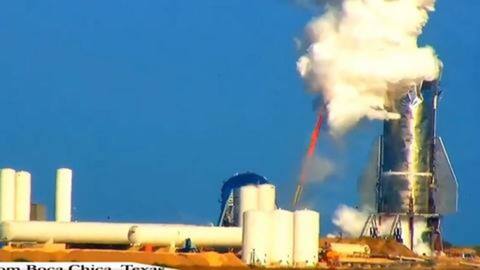SpaceX Starship prototype suffers anomaly, blows up partially in test
What's the story
The 'Mk1' prototype of Elon Musk's highly-ambitious Starship rocket has blown up partially during a ground test conducted at the company's test site in Boca Chica, Texas. According to reports, the rocket popped its top open after suffering an anomaly during the test. The details are fairly limited at this stage but SpaceX says it is not a major setback. Here's all about it.
Test
Full-scale Mk1 prototype fails pressure test
SpaceX designed Mk1 as the first full-scale prototype of Starship, the rocket which will ultimately fly to Mars. Made out of stainless steel, the booster was supposed to make its first sub-orbital flight in November-December, but during a cryogenic pressure test on November 20, its top exploded, sending pieces of hardware up in the air and erupting plumes of gas all over the site.
Recording
Several site-watchers captured the incident
Several site watchers, including LabPadre, witnessed the incident and got it in on camera. The slow-motion recordings of the explosion indicated that the cryo-fluid started leaking out from the sides first before popping the top open. Either way, this failure certainly means that Mk1 will no longer perform low-altitude flight it was supposed to in November-December.
Twitter Post
Here's how Mk1 burst
RIP Starship Mk1. @LabPadre stream:https://t.co/CwiHPUf7D3 pic.twitter.com/SckLfdIhw3
— Chris B - NSF (@NASASpaceflight) November 20, 2019
Quote
This outcome was expected, says SpaceX
"The purpose of today's test was to pressurize systems to the max, so the outcome was not completely unexpected," SpaceX said in a statement issued to the media. "There were no injuries, nor is this a serious setback."
Fous
Musk indicated flight focus will shift to Mk3 prototype
Following the failure, Musk confirmed the end of the road of Mk1, saying that they will now move towards Mk3 build, designed for orbital flights. "Mk1 served as a valuable manufacturing pathfinder but flight design is quite different," the billionaire tweeted, adding that "the decision had already been made to not fly this test article and the team is focused on the Mk3 builds."
Plan
Crewed Starship flight slated to happen next year
Meanwhile, SpaceX will continue with the development and testing of Starship prototypes and eventually begin work on Super Heavy, the liquid-oxygen powered booster that will propel the rocket into space. Then, if all goes as planned, the combination of the advanced prototype and booster will be used to fly a crew of humans into orbital space and back sometime next year.
Final rocket
Eventually, this will lead to the development of final Starship
The development and testing of these prototypes and booster will help SpaceX prepare the final version of Starship (with 6 Raptor engines) and Super Heavy (with 37 Raptor engines). The combination will eventually be utilized to fly humans and cargo weighing up to 100 tons for building bases on Moon and Mars, making humanity a multi-planetary species.
